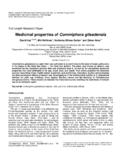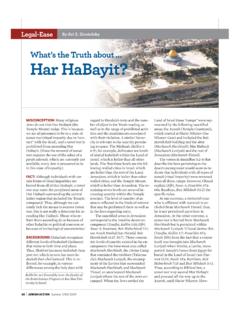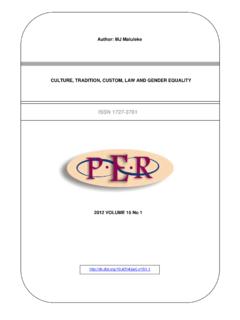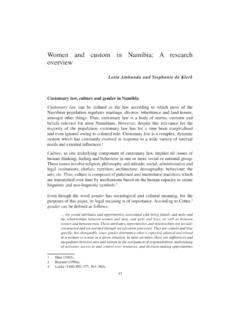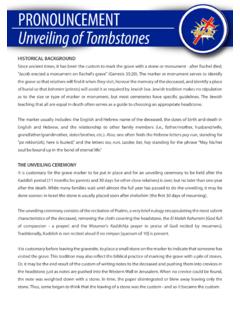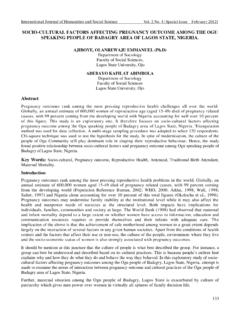Transcription of The Eating of Locusts in Jewish Tradition After the ...
1 ZOHAR AMAR. The Eating of Locusts in Jewish Tradition After the talmudic Period T. he purpose of this article is to trace the process through which the Tradition of Eating Locusts was either preserved or interrupted in Jewish communities from the talmudic period up until our own times. This study is based primarily on written sources, most of which deal with halakhic matters. Additional material of significance was collected in the course of interviews held with hundreds of people, particularly those of Yemenite and North African origin, who were accustomed to Eating kosher Locusts (until the 1950's) based on an oral Tradition which they had held for The Torah considered various types of insects kosher, and permitted their consumption according to clearly defined signs of cleanliness: Yet these may you eat of every winged swarming thing that goes upon four, which have legs above their feet to leap with upon the earth.
2 These of them you may eat: the locust (arbeh) After its kind, and the sal am After its kind, and the After its kind, and the After its kind (Lev. 11: 21-22). ZOHAR AMAR is senior lecturer in the Department of Land of Israel Studies at Bar- Ilan University. He is an expert on the flora and fauna of the land of Israel, the material culture and realia of the Middle Ages, and the history of medicine. Among his publications, which include several books and dozens of monographs and scholarly articles, are Agricultural Products in the Land of Israel in the Middle Ages (2000), Physicians, Drugs and Remedies in Jerusalem from the 10th-18th Centuries (with E. Lev), and The Book of Incense (2002). 186 The Torah u-Madda Journal (11/2002-03). Zohar Amar 187. The rabbinic sages listed the signs that determine if an insect is kosher (H. ullin 3:7), and other signs were added according to a tradi- also dealt with the identification of the kosher Locusts men- tioned in the Torah, since by their time Locusts were no longer widely known by their biblical names and therefore had to be identified and named using contemporaneous terminology: The Rabbis learned: These may you eat, etc.
3 The locust this is govay; the sal'am this is rashon; this is nipol; this is gidan. What does it mean After its kind? The term After its kind is written four times in order to include the z. ipporet keramim and the Jerusalem , and the arz. uvya and the razbanit.. And doesn't the z. arz. ur have four legs and four wings that bend and its wings cover its body? Perhaps it is permitted? We learn: Its name is ( 65a-b). In total, Rambam notes eight types of insects considered kosher according to the Torah and the rabbinic These names, how- ever, do not necessarily refer to specific species of insects in the sense of contemporary scientific nomenclature, but rather to groups of insects with specific characteristics as indicated by the rabbinic literature ( 65a-b). The custom of Eating Locusts was clearly very widespread during the period of the Mishnah and the Talmud and is documented in many sources.
4 I will bring only a few examples here. The earliest text docu- menting the Eating of insects in the Land of Israel during the Second Commonwealth is found in the book Berit Damesek. This work, one of the Dead Sea Scrolls written by a Judean Desert sect independent from the Pharisees at the end of the Second Commonwealth, quotes the fol- lowing rule: And all of the grasshoppers of their kinds shall be brought in fire or water while still alive for this is the law of their creation. 4 A. discussion is brought in the Mishnah dealing with the question of what blessing is to be recited upon Eating the locust, govay (Berakhot 6:3). Locusts were to be treated like fish, in that they are not involved in any of the prohibitions concerning milk and meat ( 8:1). Locusts were considered among the basic foodstuffs of humans5 and could be preserved for long periods of time. Locusts were prepared for con- sumption by detaching their wings with a knife and peeling them as one peels the scales off fish.
5 6 From rabbinic sources we learn that Locusts were boiled or pickled in salt and vinegar to preserve The Mishnah also describes the preparation of a locust soup : Non- kosher Locusts which were pickled with kosher Locusts are not ruled as making the sauce unfit. Rabbi Z. adok ruled that the sauce of non- 188 The Torah u-Madda Journal kosher Locusts is pure. 8 Locusts were pickled in special barrels known as gevonta from the word govay Locusts were also stored in heftek, which Rashi explains as : the storage place for salted Locusts . 10. The modern attempt to identify the types of kosher winged swarming things is problematic. Only the arbeh (in Arabic, garad). has been clearly identified as the locust, while the other kinds cannot be defined with certainty. Locust is the name given to the types of grasshoppers that tend to appear in vast swarms, and the term refers mainly to the desert locust (Schistocerca gregaria).
6 Most suggestions for identification accept that the sal am, h. argol, and h. agav mentioned in the Torah are types of insects in which the swarming instinct does not The main conclusion that emerges from these studies is that many types of kosher insects had formerly been identified through a Tradition ;. some of them were destructive and appeared in swarms or groups, while others existed as individual insects. However, over the generations the tra- dition regarding most of the types was forgotten, and in practice only the locust After its kind, arbeh, has been eaten in the past several The Tradition regarding the locust was preserved due to its importance as food in contrast with the other types of winged insects, and the centrality of the locust as a staple also explains why it is mentioned first in the Torah among those permitted as food. The process through which the Tradition was lost regarding the other types (sal am, , and ) was pro- longed and gradual, and apparently began After the talmudic period.
7 However, over time there has been an erosion among Jewish communities of the Tradition for identifying the locust as well. It should be noted that the term , although originally used to refer to an unidentified type of insect, was later used as a synonym for arbeh, the type identified as the locust. Ashkenaz and Provence By the early Middle Ages, the Jewish communities in Ashkenaz and Provence were no longer familiar with the names of the kosher Locusts . Discussion in the writings of the halakhic authorities of Europe reveals a gradual process of erosion in the Tradition of identifying Locusts for the purpose of Eating them. The rishonim note this process only concerning their own locale, apparently acknowledging that the Eating of kosher Locusts was accepted practice in other regions in their time, but we find that the did not know that this Tradition was practiced at all.
8 Zohar Amar 189. Rashi's words lead us to conclude that he knew of the types of Locusts commonly found in the areas of Europe with which he was familiar. However, the Jews of his time and place did not have a tradi- tion allowing them to distinguish between the characteristic signs of the kosher and non-kosher types of Locusts . And there are many among us in our place, such as those that are known as langosta. However, we lack expert familiarity with them, for they had four signs of ritual purity: four legs and four wings, jointed legs, and wings covering most of the body. These signs are present in those found among us, but there are some with a long head and some that have no tail, and its name should be In this sense, we do not know how to differentiate among them (Rashi, Lev. 11:21). Rashi calls the Locusts langosta (this is their name in Spanish today), and the same term is used later by Jacques de Vitry (1220) to describe the Locusts eaten in the East by the natives.
9 De Vitry, who was of French origin, went to Israel during the Crusader Period and served as the Bishop of Acre. In an essay, he referred to the Christian Tradition that notes that John the Baptist ate Locusts (Matthew 3:4). According to de Vitry, this did not actually refer to Locusts , but rather to langosta, which is also the name of a This interpretation indicates that, at that time, Locusts were not a common item in the typical food basket in France, and Eating them was considered unusual. R. Menah. em ben Shelomoh ha-Meiri (1249 1316), one of the greatest talmudic commentators in Provence, noted the absence of a tra- dition of locust Eating in his day. As a commentator also aware of the contemporary Spanish traditions, Meiri contrasts the Sefardi Tradition of Eating Locusts with the practice in Provence: There are those who permit Eating them according to the four signs, even though they are not known by the name of , and in many places in Spain, they are eaten on the basis of the four signs according to what the testified, and not necessarily by the Tradition that they were known as And in these countries we have seen that the sages, the , testified that they checked them and found them to possess the four signs; however, it is not the custom to allow them to be eaten since we have not been informed that they are included under the name of 14.
10 In the rishonim we detect an apologetic tone for the lack of a tradi- tion for identifying kosher Locusts in their countries, in contrast with other locales, such as Spain; among the , however, the phras- ing is much sharper and clearer. An explanation for the lack of familiar- 190 The Torah u-Madda Journal ity with the various species of locust in Provence is offered by R. Levi ben Gershom (Ralbag, 1288 1344) in his commentary on the Torah: .. these are the types that are difficult to know, and all the more so for us, due to our lack of expertise in the Holy Tongue at this time in which we live. 15 In contrast, R. David Shemuel ha-Levi (1588 1667) wrote in his commentary on the Arukh: And now the custom is not to eat any locust even when it is known that its name is ,' because we are not knowledgeable about their names. 16. The closer we draw to modern times, the greater the reservations of the posekim of Ashkenaz regarding the Eating of Locusts .

